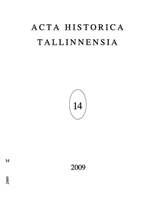VEEL KONSTANTIN PÄTSIST JA TEMA SUHETEST NÕUKOGUDE LIIDU TALLINNA SAATKONNAGA
ONCE MORE ABOUT KONSTANTIN PÄTS AND HIS RELATIONSHIP WITH THE SOVIET LEGATION IN TALLINN
Author(s): Magnus IlmjärvSubject(s): History
Published by: Teaduste Akadeemia Kirjastus
Keywords: Estonia; Estonian History; KONSTANTIN PÄTS ; SOVIET LEGATION ; TALLINN
Summary/Abstract: Ten years ago the author published in Acta Historica Tallinnensia an article that caused heated controversy in as well as outside Estonia. The article examined the relationship of the former Estonian Head of State and President Konstantin Päts with the Soviet legation in Tallinn during the period 1925–1934. Now, ten years later, it is worthwhile to return to the topic, considering the additional archival materials that are available and the public’s continued interest in the subject. The current article will address four topics: the formation of the Estonian–Russian chamber of commerce; the dismissal of Foreign Minister Kaarel Robert Pusta; the execution of the Estonian–Soviet Union trade agreement in 1929; and Päts’s participation in the activities of the oil syndicate. The decision to establish an Estonian–Russian chamber of commerce was made in Moscow. It is not entirely clear who the initiators of the idea of the chamber, founded in June of 1923 were. However, it may be assumed that it originated with the Russians, who then demanded that it be presented as if initiated in Estonia. As an example, in the case of Latvia both the Soviet ambassador and the trade representative were involved in discussions concerning the establishment of the chamber of commerce. The People’s Commissariat of Foreign Trade, however, demanded that the trade representative “in no case” assume the initiative of founding the chamber and that the initiative should come from Latvia. It can also be said that, had the founders of the Estonian–Soviet Union chamber of commerce been in any way unacceptable to the Soviet legation in Tallinn, the initiative would have failed. The correspondence between the People’s Commissariat of Foreign Affairs and the Soviet legation in Tallinn as well as that between the trade representative and the People’s Commissariat of Foreign Trade reveal that Päts had been assigned a role in the plans of the legation and the trade representative and that he played a vital role in the dismissal of Foreign Minister Kaarel Robert Pusta. Moscow was grateful to Päts that the plan to form a greater Baltic league had failed and that this had occurred because of forces within Estonia. With the year 1925 and the dismissal of Pusta the period of most intensive efforts to form the greater Baltic league ended and the league was never formed. Estonia raised the issue of a balance of trade, that is the establishment of the volume of goods to be traded, even before the completion of the trade agreement. Päts was in this instance the one who acted contrary to the position of the foreign ministry and several Estonian politicians. The Soviet Union did not agree to specify trade volumes in the agreement with Estonia even though it had done so in the agreement with Latvia in 1929. The Estonian–Soviet trade agreement, concluded in May 1929, did not provide any impetus to the Estonian economy.
Journal: Acta Historica Tallinnensia
- Issue Year: 2009
- Issue No: 14
- Page Range: 062-101
- Page Count: 40
- Language: Estonian

